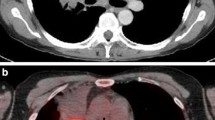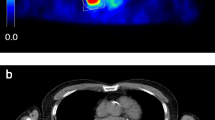Abstract
Objective
This study was performed to evaluate the effects of intravenous (i.v.) contrast agent on semi-quantitative values and lymph node (LN) staging of 18F-fluorodeoxyglucose positron emission tomography/computed tomography (18F-FDG PET/CT) in patients with lung cancer.
Methods
Thirty-five patients with lung cancer were prospectively included. Whole-body PET and nonenhanced CT images were acquired 60 min following the i.v. injection of 370 MBq 18F-FDG and subsequently, enhanced-CT images were acquired with the i.v. administration of 400 mg iodinated contrast agent without positional change. PET images were reconstructed with both nonenhanced and enhanced CTs, and the maximum and average standardized uptake values (SUVmax and SUVave) calculated from lung masses, LNs, metastatic lesions, and normal structures were compared. To evaluate the effects of the i.v. contrast agent on LN staging, we compared the LN status on the basis of SUVs (cut-offs; SUVmax = 3.5, SUVave = 3.0).
Results
The mean differences of SUVmax in normal structures between enhanced and nonenhanced PET/CT were 15.23% ± 13.19% for contralateral lung, 8.53% ± 6.11% for aorta, 5.85% ± 4.99% for liver, 5.47% ± 6.81% for muscle, and 2.81% ± 3.05% for bone marrow, and those of SUVave were 10.17% ± 9.00%, 10.51% ± 7.89%, 4.95% ± 3.89%, 5.66% ± 9.12%, and 2.49% ± 2.50%, respectively. The mean differences of SUVmax between enhanced and nonenhanced PET/CT were 5.89% ± 3.92% for lung lesions (n = 41), 6.27% ± 3.79% for LNs (n = 76), and 3.55% ± 3.38% for metastatic lesions (n = 35), and those of SUVave were 3.22% ± 3.01%, 2.86% ± 1.71%, and 2.33% ± 3.95%, respectively. Although one LN status changed from benign to malignant because of contrast-related artifact, there was no up- or down-staging in any of the patients after contrast enhancement.
Conclusions
An i.v. contrast agent may be used in PET/CT without producing any clinically significant artifact.
Similar content being viewed by others
References
R Bar-Shalom L Guralnik M Tsalic M Leiderman A Frenkel D Gaitini et al. (2005) ArticleTitleThe additional value of PET/CT over PET in FDG imaging of oesophageal cancer Eur J Nucl Med Mol Imaging 32 918–24 Occurrence Handle15838691 Occurrence Handle10.1007/s00259-005-1795-y
T Beyer DW Townsend T Brun PE Kinahan M Charron R Roddy et al. (2000) ArticleTitleA combined PET/CT scanner for clinical oncology J Nucl Med 41 1369–79 Occurrence Handle10945530 Occurrence Handle1:STN:280:DC%2BD3cvitFCguw%3D%3D
YK Chen HJ Ding CT Su YY Shen LK Chen AC Liao et al. (2004) ArticleTitleApplication of PET and PET/CT imaging for cancer screening Anticancer Res 24 4103–8 Occurrence Handle15736459
JH Kim J Czernin MS Allen-Auerbach BJ Fueger JR Hecht O Ratib et al. (2005) ArticleTitleComparison between 18F-FDG PET, in-line PET/CT, and software fusion for restaging of recurrent colorectal cancer J Nucl Med 46 587–95 Occurrence Handle15809480
C Nanni D Rubello S Fanti M Farsad V Ambrosini L Rampin et al. (2006) ArticleTitleRole of 18F-FDG-PET and PET/CT imaging in thyroid cancer Biomed Pharmacother 60 409–13 Occurrence Handle16891093 Occurrence Handle10.1016/j.biopha.2006.07.008 Occurrence Handle1:CAS:528:DC%2BD28XhtVagtLbK
S Yuan Y Yu KS Chao Z Fu Y Yin T Liu et al. (2006) ArticleTitleAdditional value of PET/CT over PET in assessment of locoregional lymph nodes in thoracic esophageal squamous cell cancer J Nucl Med 47 1255–9 Occurrence Handle16883002
GW Goerres GK von Schulthess HC Steinert (2004) ArticleTitleWhy most PET of lung and head-and-neck cancer will be PET/CT J Nucl Med 45 66S–71S Occurrence Handle14736837
G Antoch J Stattaus AT Nemat S Marnitz T Beyer H Kuehl et al. (2003) ArticleTitleNon-small cell lung cancer: dual-modality PET/CT in preoperative staging Radiology 229 526–33 Occurrence Handle14512512 Occurrence Handle10.1148/radiol.2292021598
D Lardinois W Weder TF Hany EM Kamel S Korom B Seifert et al. (2003) ArticleTitleStaging of non-small-cell lung cancer with integrated positron-emission tomography and computed tomography N Engl J Med 348 2500–7 Occurrence Handle12815135 Occurrence Handle10.1056/NEJMoa022136
LE Albertyn (1989) ArticleTitleRationales for use of intravenous contrast medium in computed tomography Australas Radiol 33 29–33 Occurrence Handle2653296 Occurrence Handle1:STN:280:BiaB38jovFA%3D
G Antoch LS Freudenberg T Beyer A Bockisch JF Debatin (2004) ArticleTitleTo enhance or not to enhance? 18F-FDG and CT contrast agents in dual-modality 18F-FDG PET/CT J Nucl Med 45 56S–65S Occurrence Handle14736836 Occurrence Handle1:CAS:528:DC%2BD2cXht1arur8%3D
G Anotoch LS Freudenberg T Egelhof J Stattaus W Jentzen JF Debatin et al. (2002) ArticleTitleFocal tracer uptake: a potential artifact in contrast-enhanced dual-modality PET/CT scans J Nucl Med 43 1339–42
G Anotoch LS Freudenberg J Stattaus W Jentzen SP Mueller JF Debatin et al. (2002) ArticleTitleWhole-body positron emission tomography-CT: optimized CT using oral and IV contrast materials AJR Am J Roentgenol 179 1555–60
T Beyer G Antoch S Muller T Egelhof LS Freudenberg J Debatin et al. (2004) ArticleTitleAcquisition protocol considerations for combined PET/CT imaging J Nucl Med 45 25S–35S Occurrence Handle14736833
Y Nakamoto BB Chin DL Kraitchman LP Lawler LT Marshall RL Wahl (2003) ArticleTitleEffects of nonionic IV contrast agents at PET/CT imaging: phantom and canine studies Radiology 227 817–24 Occurrence Handle12773683 Occurrence Handle10.1148/radiol.2273020299
BT Kim KS Lee SS Shim JY Choi OJ Kwon H Kim et al. (2006) ArticleTitleStage T1 Non-small cell lung cancer: preoperative mediastinal nodal staging with integrated FDG PET/CT – a prospective study Radiology 241 501–9 Occurrence Handle16966480 Occurrence Handle10.1148/radiol.2412051173
SS Gambhir J Czernin J Schwimmer DH Silverman RE Coleman ME Phelps (2001) ArticleTitleA tabulated summary of the FDG literature J Nucl Med 42 1S–93S Occurrence Handle11483694 Occurrence Handle1:STN:280:DC%2BD3Mvjs1Wgtw%3D%3D
H van Tinteren OS Hoekstra EF Smit JH van den Bergh AJ Schreurs RA Stallaert et al. (2002) ArticleTitleEffectiveness of positron emission tomography in the preoperative assessment of patients with suspected non-small-call lung cancer: the PLUS multicentre randomized trial Lancet 359 1388–93 Occurrence Handle11978336 Occurrence Handle10.1016/S0140-6736(02)08352-6
J Czernin H Schelbert (2004) ArticleTitlePET/CT imaging: facts, opinions, hopes, and questions J Nucl Med 45 1S–3S
DW Townsend T Beyer PE Kinahan T Brun R Roddy R Nutt et al. (1998) ArticleTitleThe SMART scanner: a combined PET/CT tomography for clinical oncology IEEE Nucl Sci Symp Conf Rec 2 1170–4
RJ Alfidi J Haaga TF Meaney WJ MacIntyre L Gonzalez R Tarar et al. (1975) ArticleTitleComputed tomography of the thorax and abdomen: a preliminary report Radiology 117 257–64 Occurrence Handle1178849 Occurrence Handle1:STN:280:CSmD3s3msVQ%3D
FA Beurgener DJ Hamlin (1981) ArticleTitleIntravenous contrast enhancement in computed tomography of pelvic malignancies Rofo 134 656–61
MJ Kormano MJ Goske DJ Hamlin (1981) ArticleTitleAttenuation and contrast enhancement of gynecologic organs and tumors in CT Eur J Radiol 1 307–11 Occurrence Handle7346277 Occurrence Handle1:STN:280:Bi2B287nt1M%3D
MR Violante PB Dean (1980) ArticleTitleImproved detectability of VX2 carcinoma in the rabbit liver with contrast enhancement in computed tomography Radiology 134 237–9 Occurrence Handle7350611 Occurrence Handle1:STN:280:Bi%2BD1c%2FntFA%3D
PR Garrett SL Meshkov GS Perlmutter (1984) ArticleTitleOral contrast agents in CT of the abdomen Radiology 153 545–6 Occurrence Handle6484186 Occurrence Handle1:STN:280:BiqD3MrmsFU%3D
YY Yat WS Chan YM Tam P Vernon S Wong M Coel et al. (2005) ArticleTitleApplication of intravenous contrast in PET/CT: does it really introduce significant attenuation correction error? J Nucl Med 46 283–91
O Mawlawi JJ Erasmus RF Munden T Pan AE Knight HA Macapinlac et al. (2006) ArticleTitleQuantifying the effect of IV contrast media on integrated PET/CT: clinical evaluation AJR Am J Roentgenol 186 308–19 Occurrence Handle16423932 Occurrence Handle10.2214/AJR.04.1740
Author information
Authors and Affiliations
Corresponding author
Rights and permissions
About this article
Cite this article
An, YS., Sheen, S., Oh, Y. et al. Nonionic intravenous contrast agent does not cause clinically significant artifacts to 18F-FDG PET/CT in patients with lung cancer. Ann Nucl Med 21, 585–592 (2007). https://doi.org/10.1007/s12149-007-0066-3
Received:
Accepted:
Published:
Issue Date:
DOI: https://doi.org/10.1007/s12149-007-0066-3




